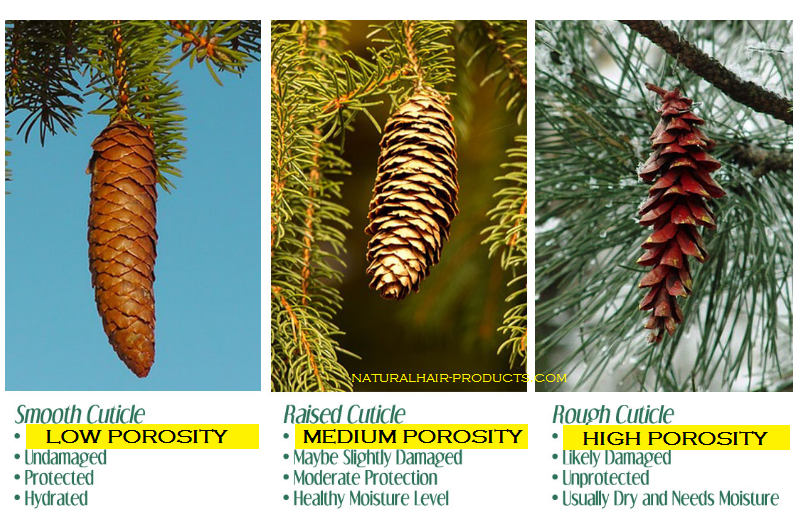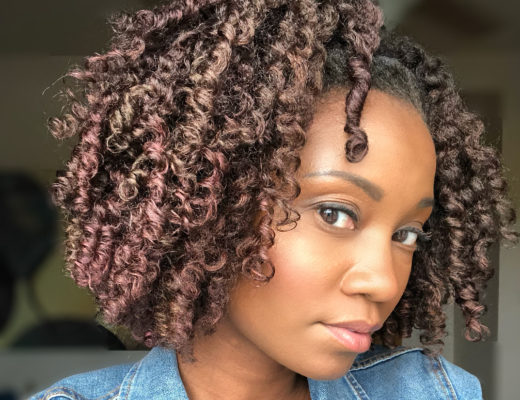This page may contain affiliate links. Read my full disclosure for more info.
Go to any natural hair website or YouTube channel, and you’re bound to come across the term porosity. Your hair’s porosity is often a better gauge for what products and techniques to use than your hair type.
So, what is porosity anyway? That’s the test where you put your hair in a glass of water and see if it sinks or floats, the one you’ve been meaning to do, right? Yes and no. Read on to learn more.
What is porosity?
Put simply, porosity is how easily your hair absorbs water.
Using the example of a sponge, one that absorbs only small amounts of water is considered low porosity, and one that absorbs a lot is considered high porosity.
Low porosity vs High porosity
When it comes to hair, what determines its porosity?
Our hair strands have a “cuticle” layer. This cuticle covers the entire surface of each hair strand. It is made up of scales that overlay each other like shingles on a roof.
When these scales lay very flat and tightly against one another, they hinder water from absorbing into the hair – this is low porosity hair.
When the scales are lifted, chipped, or missing, they allow more water to absorb into the hair – this is high porosity hair.

Image source: www.naturalhair-products.com
This image is an excellent visual for thinking about the cuticle layer of the hair in relation to porosity.
To reiterate, low porosity hair stays hydrated for longer but can be difficult to hydrate in the first place because the outer layer of the strands are more difficult to penetrate.
High porosity hair loses moisture easily but is initially easier to hydrate because the cuticle is lifted and/or broken and easier to penetrate.
Medium porosity hair is, you guessed it: just right.
Float or sink porosity test
What about those float/sink hair porosity tests?
You’ve probably seen the numerous blog posts, pins and Facebook posts about putting a strand of your hair in a glass of water to see if it sinks or floats, in order to determine your hair’s porosity.
While this test seems like a great, inexpensive at-home way to find out what you’re working with, JC of The Natural Haven debunks this hair porosity test as junk science.
The coating of oil on your hair, its density, and other factors affect whether your hair floats or sinks.
So, how can we tell if we’re low or high?
Use the following list of hair characteristics as a guide:
Low Porosity
- Products seem to sit on top of my hair instead of being absorbed
- My hair takes a minute to get fully wet in the shower
- My hair takes a long time to dry
- My hair is shiny
- My hair has little volume
High Porosity
- My hair “soaks up” products no matter how much I use
- My hair gets wet immediately in the shower
- My hair dries out quickly
- My hair is big and voluminous
- My hair doesn’t have a lot of shine
There is plenty of variation in every head of hair. You may have both low and high porosity strands, and it’s also possible to have medium porosity. You could have low porosity hair that doesn’t have a lot of shine because of your texture and how it reflects light, so these lists aren’t written in stone. Use them as a starting point in thinking about your unique hair and what it needs.
How does porosity affect your hair care routine?
Low Porosity
If you have low porosity hair, you have to make extra effort to get moisture into your strands. Many low porosity naturals have success with hair steamers and deep conditioning with heat.
Low porosity hair can be prone to product buildup since products lay on top of the tightly bound cuticle scales instead of being absorbed. It’s important to keep an eye out for this, and shampoo with a clarifying shampoo periodically to remove buildup. Lighter oils, moisturizers, and stylers are a good option.
Low porosity hair can also be protein sensitive. Protein treatments are usually used to fill dings and cracks in damaged cuticle scales. Excessive use of protein on low porosity hair tends to create dry, brittle hair since there aren’t a lot of gaps in the cuticle to fill.
High Porosity
If you have high porosity hair, your hair absorbs moisture quickly, but also releases it just as quickly, so it feels dryer sooner. Thicker oils and butters will help to seal moisture into your hair. Heavier moisturizers and stylers may fare well.
Since the hair dries out easily, cowashing or gentle shampoos work well, with clarifying shampoos used less often.
Since the hair absorbs water easily, keep an eye out for hygral fatigue, where the hair becomes overly elastic and gummy from swelling with water. Protein treatments may need to be used more frequently in order to repair the cuticle and help the hair hold moisture.
Porosity lab
If you’re a visual learner like me, check out this video where Sister Scientist breaks porosity all the way down:
Conclusion
Knowing your hair’s porosity can do more in helping you choose products and techniques than hair type does. Armed with this info, you will understand not only what works and what doesn’t, but why, allowing you to make informed choices about your hair care regimen.
For more natural health, beauty, and lifestyle inspiration, join me on Instagram and Pinterest.







Great article. I agree porosity is more important than curl pattern when making choices about the products we use and our hair regimen.
There is now an affordable way to test hair porosity–with a % porosity rather than a low, medium, high. As our % porosity changes, this can be helpful information to understand if we’re on the right path to improving the health of our hair.